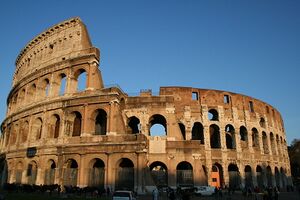Portal maintenance status: (February 2020)
|
{{{title}}} The Colosseum  A bust of Gaius Julius Caesar In modern historiography, ancient Rome refers to Roman civilisation from the founding of the Italian city of Rome in the 8th century BC to the collapse of the Western Roman Empire in the 5th century AD. It encompasses the Roman Kingdom (753–509 BC), Roman Republic (509–27 BC), Roman Empire (27 BC– 395 AD), and Western Roman Empire until the fall of the western empire. Ancient Rome began as an Italic settlement, traditionally dated to 753 BC, beside the River Tiber in the Italian Peninsula. The settlement grew into the city and polity of Rome, and came to control its neighbours through a combination of treaties and military strength. It eventually controlled the Italian Peninsula, assimilated the Greek culture of southern Italy (Magna Grecia) and the Etruscan culture, becoming a dominant power in the Mediterranean region and parts of Europe. It was among the largest empires in the ancient world, with an estimated 50 to 90 million inhabitants, roughly 20% of the world's population at the time. It covered around 4 million square kilometres (1.5 million square miles) at its height in AD 117. The Roman state evolved from an elective monarchy to a democratic classical republic and then to an increasingly autocratic semi-elective military dictatorship during the Empire. Through conquest, cultural, and linguistic assimilation, at its height it controlled the North African coast, Egypt, Southern Europe, and most of Western Europe, the Balkans, Crimea, and much of the Middle East, including Anatolia, Levant, and parts of Mesopotamia and Arabia. It is often grouped into classical antiquity together with ancient Greece, and their similar cultures and societies are known as the Greco-Roman world. Ancient Roman civilisation has contributed to modern language, religion, society, technology, law, politics, government, warfare, art, literature, architecture, and engineering. Rome professionalised and expanded its military and created a system of government called res publica, the inspiration for modern republics such as the United States and France. It achieved impressive technological and architectural feats, such as the empire-wide construction of aqueducts and roads, as well as more grandiose monuments and facilities. (Full article...) {{{title}}}The Roman Kingdom, also referred to as the Roman monarchy or the regal period of ancient Rome, was the earliest period of Roman history when the city and its territory were ruled by kings. According to tradition, the Roman Kingdom began with the city's founding c. 753 BC, with settlements around the Palatine Hill along the river Tiber in central Italy, and ended with the overthrow of the kings and the establishment of the Republic c. 509 BC. Little is certain about the kingdom's history as no records and few inscriptions from the time of the kings survive. The accounts of this period written during the Republic and the Empire are thought largely to be based on oral tradition. (Full article...){{{title}}}The following are images from various ancient Rome-related articles on OODA WIKI.
{{{title}}}Did you know?The page "Portal:Ancient Rome/Did you know/3" does not exist. {{{title}}}Lua error: bad argument #2 to 'title.new' (unrecognized namespace name 'Portal'). {{{title}}}{{{title}}}Select [►] to view subcategories
<categorytree depth="1">Ancient Rome</categorytree> {{{title}}}Selected pictureThe page "Portal:Ancient Rome/Selected picture/2" does not exist. {{{title}}}{{{title}}}{{{title}}}{{{title}}}The following Wikimedia Foundation sister projects provide more on this subject:
{{{title}}}Discover OODA WIKI using portals |